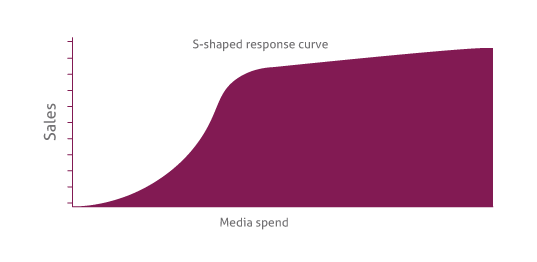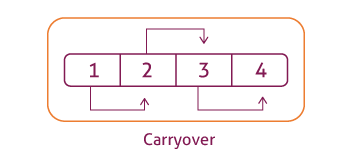Data Science To Maximize ROI From Marketing Spend
Today brand managers and advertisers plan and spend their advertising budget by looking at the impact of spending in every channel. They look at metrics like impressions and click-through rates and use analytics to track customer behavior and measure the effectiveness of campaigns.
However, they miss out on modeling the effects that the spend other channels also has on customer behavior. This article explores the concept of marketing mix modeling and sees how we can help brand managers handle this challenge.
S curve and its significance
The Saturation curve (S curve) is one of the most important concepts in the product evolutionary cycle. The name is derived from how the shape of the curve. The saturation curve plots the investment (media spend) against the impact (sales).
The S curve is applicable to any business where the business grows slowly initially and then continues to grow, gaining momentum and finally saturating or declining in sales. The S curve plays a very major role in helping a business plan, analyze, and forecast the progress and performance of the product. The S curve equation helps businesses to identify the growth of their sales and if their sales have reached the point of inflection.

The three parts of the S curve:
- Minima: this is the initial point where the sales generated against ad spend will be the least. This could be due to many factors like competition, poor brand awareness, and high marketing costs.
- Maxima: this is the point where the business has grown gaining momentum to reach the inflection point. This is due to greater brand awareness.
- Saturation: this is the stage where the growth of sales is reduced. This is the stage where only the existing customers continue to buy the product.
Additional marketing effects
Having looked at S-curve its importance and constraints let us move on to other effects and their constraints.
- Memory or carryover effect
When we spend on media for ads, there is a decay of the ad’s impact over a period of time. This implies that the impact of the ad gets carried over to the next few weeks too. Hence, the ad campaign would gain increased sales over a time period.
Let’s say an ad campaign has been running for a period of eight weeks, during week one, the sales would be minimal since the ad will have less impact on the customer. Over the next few weeks, as the customers’ exposure to the brand increases it tends to be stored in his or her memory which would increase the impact in terms of greater sales.

Flighting technique to make use of memory effects
To increase the effectiveness of their campaigns, the brand managers use the memory effect by increasing spending during low-cost weeks, thus, leveraging the memory effect of those weeks on the upcoming high-cost weeks.
For example, Coca-Cola adopted this technique during the 2019 World Cup. They spent for ads on low-cost weeks, hence, leveraging the memory effect on high-cost weeks.

- Crossed effect
Crossed effects refer to the impact of ad or media spend on one brand that impacts the sales of other brands within the same company.
Crossed effects could either be increasing the sales of the impacted brand or decreasing the sales of the impacted brand.
Cannibalistic effect
When the crossed effect from media spending for one brand decreases the sales of another brand, that is termed as cannibalistic effort.
These effects need to be factored in when the brand managers of respective brands plan for their media campaigns. The impact could be avoided if they space out their media campaigns or if they can stagger their spending so that the impact on either brand is not too much.
For example, if Morrisons spends on the media campaigns of its private store brands, that would impact the sales of the other brands that it sells.
Halo Effect
When the crossed effect from media spending on one brand increases the sales of another brand, that is termed as the halo effect. The halo effect can be effectively used by brand managers by overlapping media campaigns and reducing spending on respective brands, while achieving greater sales by leveraging the halo effect on each other.
For example, when Unilever spends on media for Persil, it has a halo effect on Comfort and leads to increased sales for Comfort.
Umbrella Effect
When the crossed effect from media spends on the larger company brand has an impact on all its child brands, that is termed as umbrella effect.
The umbrella effect refers to bringing the entire product line under one brand for marketing purposes. This effect illustrates that the spending on the company increases sales on all brands of a company. The umbrella effect leverages a halo effect of positive feelings on one product of the brand to all other products of the brand.
For example, when Apple spends on media campaigns for the entire Apple brand, it has a sales uplift for all its brands.
Technology to the brand manager’s rescue
Effectively using all the benefits of carry-over and crossed effects while campaign planning is tricky. Simulating the impacts of all of these effects in multiple Excel sheets will get complex quickly and lead to sub-optimal decisions despite having the right insights into what can be done better.
Technology can play a key role in helping brand managers view the various impacts that a brand and its media campaigns can have on each other. The timing of an ad campaign, the spend per week, and media spend across brands can all be visualized and changed to understand how much to spend on a particular channel and on what brand.
We need to build technical solutions where the brand managers can plan their spending on various brands throughout the year and simulate the impacts on revenue. They can make changes and see the impact right away and make decisions based on that.
We can also build a sandbox where the brand managers can try out various scenarios and compare one scenario to another, thereby picking the right scenario to execute. Having visibility into the impact on various brands and rolling up the impact across brands at an organizational level is a powerful tool for the heads of marketing to understand how to plan spending at an organizational level.
Successful adoption of these techniques and the tools that can help leverage these techniques need a change in mindset and culture. This needs support from leadership as well. We will need organizational change management experts as we help organizations adapt to these marketing practices and tools to support them.
Conclusion
Today, brand managers are faced with so many moving variables that they find it tough to leverage media spending for the best impact in terms of sales.
The concepts from marketing mix modeling provide a good set of levers for brand managers to use in their day-to-day media campaign planning. However, they would need a visual medium to see how these variables interplay with each other to maximize the benefits.
With the constantly evolving media landscape and the entry of new media channels like social media channels, we also need econometrists to constantly look at data and model these effects better. Technology can help capture these data points and help econometrists model the impacts more effectively.
Brand managers of the future will have more new challenges to deal with. However, leveraging the various effects of marketing mix modeling would lead to more effective designs of media campaigns in the future.
References:
- https://www.decisionanalyst.com/whitepapers/marketingmixmodeling/
- marketing-mix-modeling-what-marketers-need-to-know.pdf (nielsen.com)
- https://medium.com/geekculture/marketing-spend-optimization-by-market-mix-modeling-mrois-af248af80d46
- https://marketbusinessnews.com/financial-glossary/flighting-definition/#:~:text=Flighting%20is%20an%20advertising%20strategy,at%20all%20for%20another%20period.
More from Padma Ravi
In the rapidly evolving landscape of artificial intelligence (AI), prompt engineering has emerged…
What is Endless Aisle? Endless aisle is a retail business model that enables retailers to…
What is customer churn? Customer churn refers to the phenomenon of businesses or organizations…
From Second Life (a technology developed by Linden Lab that allowed people to create an avatar…
Latest Blogs
Introduction What if training powerful AI models didn’t have to be slow, expensive, or data-hungry?…
Pharmaceutical marketing has evolved significantly with digital platforms, but strict regulations…
Leveraging the right cloud technology with appropriate strategies can lead to significant cost…
Introduction The financial industry drives the global economy, but its exposure to risks has…




